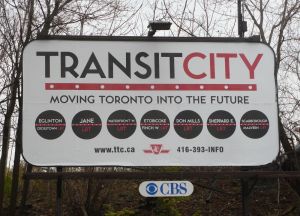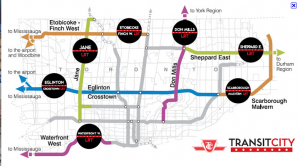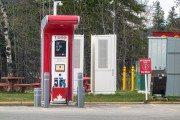I'm a big fan of Toronto's subway. It's affordable and usually fast, frequent and reliable — adjectives that few drivers in Toronto would use to describe their commute. So you would think I'd be thrilled with Toronto Mayor Rob Ford's proposal to extend the subway line.
But I'm not, and I find it odd that a mayor who campaigned on "stopping the gravy train" at City Hall is proposing the most expensive of all transit options.
Estimates for building a new eight-kilometre stretch of subway east from the Don Mills station hover around $400-million per kilometre (including new stations). In stark contrast, building light rail transit along the same stretch would cost about $90-million per kilometer, or less than a quarter of the cost.
That's why Toronto's previous city council chose light rail transit as the cornerstone of its Transit City plan — because hands down it provides the best bang for the buck.
Unlike Toronto's familiar and iconic streetcars or its buses, light rail transit has the right of way with its own traffic signals, enabling frequent, reliable, fast and comfortable transit. And if one thing is clear in Toronto, it's that we need to get way more efficient at moving ourselves around the city.
The Better Way?
Rob Ford has a plan to replace Transit City with subways and roads instead. Sounds great to the subway enthusiast, but his plan is only for one new subway line — the Sheppard east extension — at the expense of rapid transit for the rest of the city.
 In total, Rob Ford's 12 kilometres of subway line will cost at least $7.13 billion. The price tag includes a new section from Don Mills to Scarborough and a four-kilometre westbound section connecting to Downsview station, all at a cost of $5.4 billion, including the trains. The mayor wants to convert the current Scarborough Rapid Transit section to subway, which he says will cost another $1 billion. A new rail yard might be required for an additional $500-million.
In total, Rob Ford's 12 kilometres of subway line will cost at least $7.13 billion. The price tag includes a new section from Don Mills to Scarborough and a four-kilometre westbound section connecting to Downsview station, all at a cost of $5.4 billion, including the trains. The mayor wants to convert the current Scarborough Rapid Transit section to subway, which he says will cost another $1 billion. A new rail yard might be required for an additional $500-million.
However, we also may need to pay to get out of existing contracts already signed, which are worth $1.3-billion. And we have already spent $130 million.
The Transit City plan calls for 120 kilometres of new rapid light rail lines connecting seven areas of the city, including Scarborough, that are underserved by transit. Four of these lines have been identified as high priority projects and have already received the committed funding from the province. These four priority lines would deliver 64 kilometres of new light rail rapid transit for $8.15 billion — more than five times the amount of transit at close to the same cost.
It's worth highlighting that Ford understands that his subway plan won't serve as many Torontonians. So for everybody else he's going to provide more buses, despite the fact they are slower and less reliable for riders, and carry operating costs six times higher than light rail transit on a per-rider basis.
Facing the ghost of traffic yet to come
An IBM study found that Torontonians suffer the second worst traffic-related stress of 20 international cities. Toronto's roads and highways are more congested than anywhere in North America and our drivers endure the longest average commute times — 80 minutes! Clearly, a plan to tackle this problem must strive to provide commuters with viable options, including access to rapid transit
 Ignoring the urgent need for transit infrastructure is like averting our eyes from the scary ghost of traffic yet to come. The GTA region is expected to grow by more than one million residents during the next 10 years. These people will need to get to work.
Ignoring the urgent need for transit infrastructure is like averting our eyes from the scary ghost of traffic yet to come. The GTA region is expected to grow by more than one million residents during the next 10 years. These people will need to get to work.
Meanwhile, Toronto's drivers faced another fright this week at the gas pump with a four-cent increase in the price of gas. Certainly, options to leave the car at home and take convenient, affordable transit to work either all of the time or during price peaks would be welcome by many in this city.
Underground and out of mind
Ford's solution to Toronto's traffic woes is fuelled by a desire to keep more pesky streetcars off the roads and underground and out of the way for cars.
Optimistically, Ford's new Sheppard subway line could take about 40,000 of these future cars off of the road while the four priority lines for Transit City would remove more than 100,000.
The reality is that Transit City and the whole Metrolinx regional transit plan is an effective and fiscally responsible attempt to provide viable transit options to our region's growing population.
When it comes to a cost-effective way to improve transit options and reduce commute times for Torontonians, Mayor Ford's plan doesn't "end the gravy train" — it just moves it underground.





